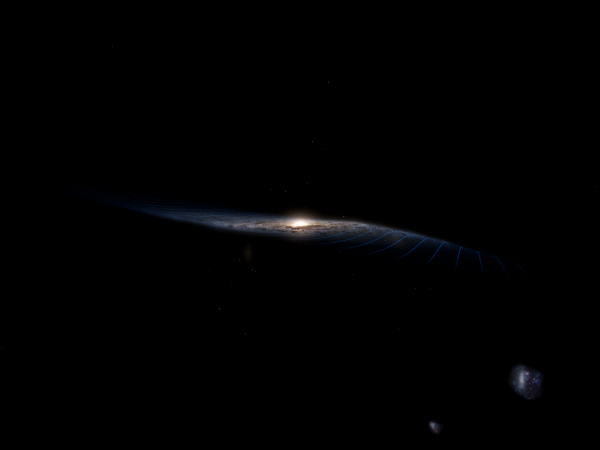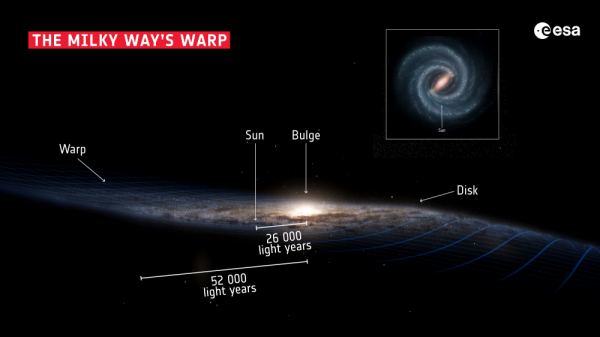Milky Way's warp caused by galactic collision, Gaia suggests
2 March 2020
Astronomers have pondered for years why our galaxy, the Milky Way, is warped. Data from ESA's star-mapping satellite Gaia suggest the distortion might be caused by an ongoing collision with another, smaller, galaxy, which sends ripples through the galactic disc like a rock thrown into water. |
| The warped disc of our galaxy, the Milky Way. Credit: Stefan Payne-Wardenaar; Magellanic Clouds: Robert Gendler/ESO |
Since the late 1950s, astronomers have known that the Milky Way's disc – where most of its hundreds of billions of stars reside – is not flat but somewhat curved upwards on one side and downwards on the other. For years, they debated what is causing this warp. They proposed various theories including the influence of the intergalactic magnetic field or the effects of a dark matter halo, a large amount of unseen matter that is expected to surround galaxies. If such a halo had an irregular shape, its gravitational force could bend the galactic disc.
With its unique survey of more than one billion stars in our galaxy, Gaia might hold the key to solving this mystery. A team of scientists using data from the second Gaia data release has now confirmed previous hints that this warp is not static but changes its orientation over time. Astronomers call this phenomenon precession and it could be compared to the wobble of a spinning top as its axis rotates.
Moreover, the speed at which the warp precesses is much faster than expected – faster than the intergalactic magnetic field or the dark matter halo would allow. That suggests the warp must be caused by something else. Something more powerful – like a collision with another galaxy.
 |
| The warped galactic disc of the Milky Way wobbles like a spinning top. Credit: Stefan Payne-Wardenaar |
"We measured the speed of the warp by comparing the data with our models. Based on the obtained velocity, the warp would complete one rotation around the centre of the Milky Way in 600 to 700 million years," says Eloisa Poggio of the Turin Astrophysical Observatory, Italy, who is the lead author of the study, published in Nature Astronomy. "That's much faster than what we expected based on predictions from other models, such as those looking at the effects of the non-spherical halo."
The warp's speed is, however, slower than the speed at which the stars themselves orbit the galactic centre. The Sun, for example, completes one rotation in about 220 million years.
Such insights were only possible thanks to the unprecedented ability of the Gaia mission to map our galaxy, the Milky Way, in 3D, by accurately determining positions of more than one billion stars in the sky and estimating their distance from us. The flying saucer-like telescope also measures the velocities at which individual stars move in the sky, allowing astronomers to 'play' the movie of the Milky Way's history back- and forward in time over millions of years.
"It's like having a car and trying to measure the velocity and direction of travel of this car over a very short period of time and then, based on those values, trying to model the past and future trajectory of the car," says Ronald Drimmel, a research astronomer at the Turin Astrophysical Observatory and co-author of the paper. "If we make such measurements for many cars, we could model the flow of traffic. Similarly, by measuring the apparent motions of millions of stars across the sky we can model large scale processes such as the motion of the warp."
 |
| The structure of our galaxy, the Milky Way. Credit: Stefan Payne-Wardenaar; Inset: NASA/JPL-Caltech; Layout: ESA |
The astronomers do not yet know which galaxy might be causing the ripple nor when the collision started. One of the contenders is Sagittarius, a dwarf galaxy orbiting the Milky Way, which is believed to have burst through the Milky Way's galactic disc several times in the past. Astronomers think that Sagittarius will be gradually absorbed by the Milky Way, a process which is already underway.
"With Gaia, for the first time, we have a large amount of data on a vast amount stars, the motion of which is measured so precisely that we can try to understand the large scale motions of the galaxy and model its formation history," says ESA's Gaia deputy project scientist Jos de Bruijne. "This is something unique. This really is the Gaia revolution."
As impressive as the warp and its precession appear on the galactic scale, the scientists reassure us that it has no noticeable effects on life on our planet.
"The Sun is at the distance of 26 000 light years from the galactic centre where the amplitude of the warp is very small," Eloisa says. "Our measurements were mostly dedicated to the outer parts of the galactic disc, out to 52 000 light years from the galactic centre and beyond."
Gaia previously uncovered evidence of collisions between the Milky Way and other galaxies in the recent and distant past, which can still be observed in the motion patterns of large groups of stars billions of years after the events occurred.
Meanwhile, the satellite, currently in the sixth year of its mission, keeps scanning the sky and a Europe-wide consortium is busy processing and analysing the data that keeps flowing towards Earth. Astronomers across the world are looking forward to the next two Gaia data releases, planned for later in 2020 and in the second half 2021, respectively, to tackle further mysteries of the galaxy we call home.
Notes for editors
"Evidence of a dynamically evolving Galactic warp" by E. Poggio et al. is published in Nature Astronomy.
For further information, please contact:
Eloisa Poggio
INAF – Turin Astrophysical Observatory, Italy
Email: eloisa.poggio![]() inaf.it
inaf.it
Ronald Drimmel
INAF – Turin Astrophysical Observatory, Italy
Email: ronald.drimmel![]() inaf.it
inaf.it
Jos de Bruijne
Gaia deputy project scientist
European Space Agency
Email: jos.de.bruijne![]() esa.int
esa.int



